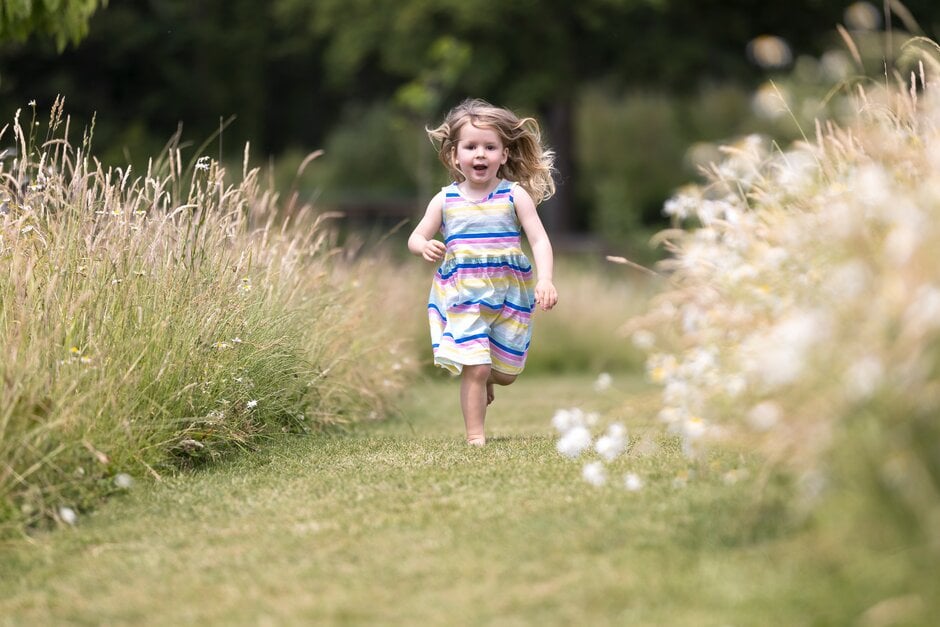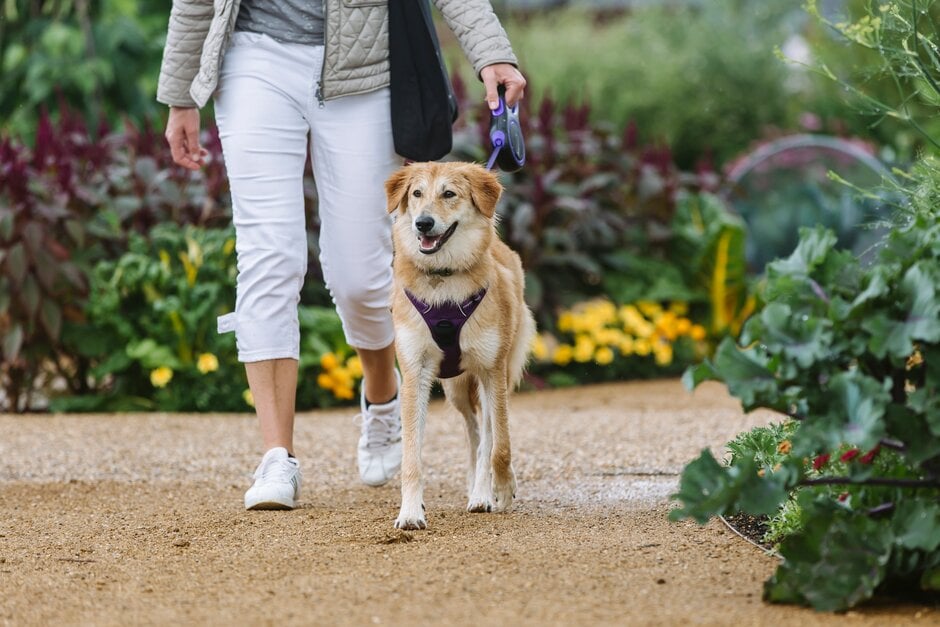Making an outdoor space that works for both you and the furry members of your family is easy and simple. Just putting some extra thought into what will keep your dogs, cats and other four-legged friends happy can help them get the most out of your garden.
Five ideas for a pet-friendly garden
1) Secure your space
You need to make sure you don’t provide any accidental escape routes for those pets who don’t know how to make it back home. Creating boundaries using fencing, walls and hedging is an easy way to ensure they don’t make an unexpected exit when you aren’t looking. Just make sure your boundaries don’t have any gaps for pets to squeeze through. You can even use boundaries to create a pet-free zone and protect areas of planting.
2) Choose plants carefully
While your pets may think some plants look good enough to eat, not all of them are safe to do so. The Blue Cross notes that toxic plants can lead to a range of problems for pets when ingested or touched, from vomiting to skin irritation and more serious illness. It is important to always research when choosing new plants for your garden to make sure they are safe for your animals.
3) Create shady spots
It can be tempting for animals to spend hours outside when the sun is shining so it is a good idea to provide cooler spots for them to retreat to avoid overheating. Shade be created in many ways, such as using trees or shelters, but it might also occur from buildings. It doesn’t have to limit your planting either, as there are many ways to work with shade in the garden.
4) Incorporate play
It’s natural for pets to be adventurous in the garden and there are lots of features you can add to keep them entertained. Hiding spots can be created using pathways between shrubs and long grasses, while providing benches and other surfaces with height, like boulders, can give them something to climb on. Having some open space for pets to run around in will also allow them to burn off energy, but visiting a local park is a great alternative if you have a smaller garden. Remember that RHS Gardens also offer different Walkies evenings for dog owners throughout the year.
5) Introduce different textures
Sensory stimulation in the garden can bring pets as much enjoyment as us. Including things like a range of grasses to roll around in, different types of path to walk on, plants you don’t mind them sniffing in and shallow water features to splash in can keep them interested for hours. Just be careful to avoid sharper edges and surfaces that could cause injuries.
At the RHS Chelsea Flower Show in May, Monty Don is creating his first Feature Garden for the RHS, with Radio Two. With the nation’s dog owners wanting beautiful spaces for them and their furry friends, The RHS and Radio 2 Dog Garden will inspire the millions of dog lovers at home to create green havens for them and their pets.
What do garden designers suggest?
Back in 2016, long-standing RHS show designer and judge Paul Hervey-Brookes celebrated the 125th anniversary of the Dogs Trust with his A Dog’s Life Garden at RHS Hampton Court Palace Garden Festival.
The aim was to create a safe space for dogs needing rehoming to meet potential owners in a garden that functioned for them. “It had a very simple layout with a long stretch of shallow water for dogs to play and cool off in and a quiet enclosed seating area at the back for dogs and people to sit together,” he said.
Inspiration from A Dog’s Life Garden
In the RSPCA Garden at the RHS Chelsea Flower Show 2023, designer Martyn Wilson demonstrated how to encourage wildlife in the garden while also taking domestic animals into consideration.
To mark the 200th birthday of the RSPCA, the garden included many wildlife features, including dead hedge boxes, a dry-stone wall and nesting boxes, as well as a hide to observe wildlife from. A dog water bowl from the 1920s was also placed in the garden to represent those that the charity put out at the time for working dogs.
What the RSPCA suggest for pet-friendly gardens…
- For rabbits and guinea pigs, attach a large run onto their shelter for exercise.
- For cats, include trees to scratch and climb.
- For dogs, designate digging areas.
Plant advice
Although most domesticated animals aren’t directly interested in plants, avoid growing those below if you are aware that your pet chews, scratches or rubs against plants. Puppies and kittens are in particularly inquisitive at teething age. Rabbits, guinea pigs and tortoises should ideally be kept in an enclosure when outdoors to protect them.
These plants are toxic if eaten by animals. Please seek veterinary assistance if you suspect your pet of coming into contact with these.
Ornamental plants
Aconitum (monkshood, wolfsbane) – spires of purple or white flowers with a characteristic hood-like petal and dark green leaves.
Allium (ornamental onion) – purple or white spherical flowers on thin stems. Leaves die back in summer.
Arum mamoratum, Arum italicum (cuckoo pint, lords and ladies, Italian lords and ladies) – green spearhead-shaped leaves. Leaves are either plain green or marbled white. Grows in gardens, woodland and beneath hedgerows.
Asarum europeaum (wild ginger, asarabacca) – a low-growing ground cover with mid-to dark green leaves. Inconspicuous red-brown flowers near ground level.
Brugmansia (angel’s trumpet, tree datura) – a frost-tender plant with large trumpet-shaped pendulous flowers in pink, yellow, orange, red, cream or white.
Colchicum (autumn crocus, meadow saffron, naked ladies) – white or pink-purple crocus-like flowers (appear in late summer autumn). Rosettes are the circular arrangement of flower petals; or a cluster of leaves radiating from approximately the same point usually around a stem. Examples include aeonium and most succulent plants, African violets, primula, sempervivums.
Convallaria (lily-of-the-valley) – a low-growing leafy groundcover plant in shady places. In spring highly scented, spherical-shaped clusters of white, or pale pink, flowers emerge on short stalks.
Daphne (spurge laurel, wood laurel, copse laurel) – widely-grown evergreen (occasionally deciduous) shrubs, with small clusters of highly scented pink, purple or white flowers in spring and summer.
Datura (thornapple, jimsonweed) – a frost-tender plant with ornamental varieties similar to brugmansia but with upright trumpet-shaped flowers in purple and white. Jimsonweed with narrow white-cream flowers appears as a casual weed on disturbed ground. All have spherical, spined seed capsules.
Dictamnus (burning bush, gas plant, dittany, fraxinella) – an upright Perennials are plants that live for multiple years. They come in all shapes and sizes and fill our gardens with colourful flowers and ornamental foliage. Many are hardy and can survive outdoors all year round, while less hardy types need protection over winter. The term herbaceous perennial is used to describe long-lived plants without a permanent woody structure (they die back to ground level each autumn), distinguishing them from trees, shrubs and sub-shrubs.
Digitalis (foxglove) – spires of tubular purple flowers in late spring-early summer often spotted inside emerge from a low growing rosette of leaves. A Biennials are plants that complete their life cycle over the course of two years. In the first year, biennials typically produce leaves and roots but no flowers. In the second year, they flower and produce seeds before dying. Some common biennials include foxgloves (Digitalis), honesty (Lunaria annua) and viper's bugloss (Echium vulgare).
Euphorbia (spurge) – bracts surround acid yellow or lime green flowers in spring and summer. Upright or trailing habit with characteristic milky sap. Toxic when ingested but also irritant of skin and eyes.
Ginkgo biloba (ginkgo, maidenhair tree) – usually an upright Deciduous refers to plants (mainly trees and shrubs) that lose their leaves seasonally, usually during autumn. This is a natural process triggered by the season's shorter days and lower temperatures and allows plants to conserve energy during the winter months.
Gourds (ornamental varieties of squash) – a scrambling annual, with small egg-or teardrop shaped fruit, striped variously yellow, orange, green and white. Some have blistered skin.
Hemerocallis (daylily) – an herbaceous perennial with trumpet-shaped flowers each lasting for a day emerge from clumps of grassy foliage. Toxic to cats in particular.
Heracleum (hogweed) – large rough-surfaced leaves emerge in spring, followed by flattened, white umbel-shaped flowers. A deep-rooted occasional garden weed in sun and part-shade. Sap is a fluid that circulates through a plant's vascular system, in a similar way to blood moving through our veins. Phloem sap carries the sugars produced in the leaves by photosynthesis down to roots and other storage organs, as well as carrying minerals and hormones. Xylem sap is watery and transports nutrients absorbed by the roots upwards to the rest of the plant. Some plants leak sap from wounds or pruning cuts, and this is known as bleeding.
Humulus lupulus (hop, golden hop) – a scrambling climber with bristly, rough-textured green or golden leaves. In late summer-autumn strings of papery, flowers with distinctive smell are present.
Lilium (lily, Easter lily, tiger lily) – large six petalled flowers in pink, red, yellow and white, often highly scented. Prominent stamens with orange pollen that stains. Poisonous to cats.
Lupinus (lupin) – spires of pea-like flowers in blue, purple, yellow, red and white, emerge from herbaceous clumps. Leaves are soft, with multiple leaflets arranged around a central stalk.
Nerium oleander (oleander, rose bay, rose laurel) a frost-tender evergreen shrub, which may survive outdoors in coastal areas. Red, pink and white ruffled flowers are produced atop thin stems with spear-shaped leaves.
Oenanthe (water dropwort, hemlock water dropwort) a A term generally applied to non-woody, flowering plants that are natural to a particular area and grow there without human assistance. More accurately, British wildflowers normally applies to UK natives including plants introduced into the wild before 1500.
Ornithogalum (star-of-Bethlehem, chincherinchee, wonder flower) A bulbous plant which flowers from late spring to summer. Star-shaped white or orange flowers.
Phytolacca (pokeweed, pokeroot, pokeberry, inkweed, inkberry, pigeonberry) an herbaceous plant with large oval leaves, flowers in summer are followed by round shiny black fruit on pink stems.
Polygonatum (Solomon’s seal) – an herbaceous plant with paired leaves ascending on arching stems. Pendulous white-green flowers are seen beneath the foliage in spring.
Ricinus communis (castor oil plant, caster bean, palma Christi) – an Annuals are plants that complete their life cycle in one growing season. They are generally easy to grow from seed or can be bought as young plants from garden centres. Annuals are ideal for growing in summer containers and filling gaps in borders. Some examples of annuals include sunflowers, cosmos, sweet peas and zinnia.
Ruta (rue, garden rue, herb of grace, Jackman’s blue) – a low growing, mound-forming plant, sometimes seen in herb gardens. Has well divided blue-green leaves and sulphur yellow flowers in summer. Toxic to skin in sunlight.
Taxus (yew) – a bushy tree with dark green leaves, red-brown Bark is the outermost layer of woody plants (trees, shrubs and woody climbers). It is several cells thick and provides protection against physical damage, disease and environmental stresses. Bark comes in a wide variety of colours and patterns, and these can help gardeners when identifying plants. The fissures and crevices of bark on older plants also creates valuable habitat for many garden creatures as well as lichens and small plants.
Veratrum (false hellebore, false helleborine) a herbaceous plant with large pleated leaves that emerge in spring. These are followed by branched panicles of dark-reddish brown or white-green flowers.
Edible plants
Plants in the onion family such as garlic, chives and onions are best avoided, or grown in an fenced area.
There are more resources about garden safety for pets available from animal charities such as the Dogs Trust, Blue Cross, HTA, the PDSA, and the RSPCA.


